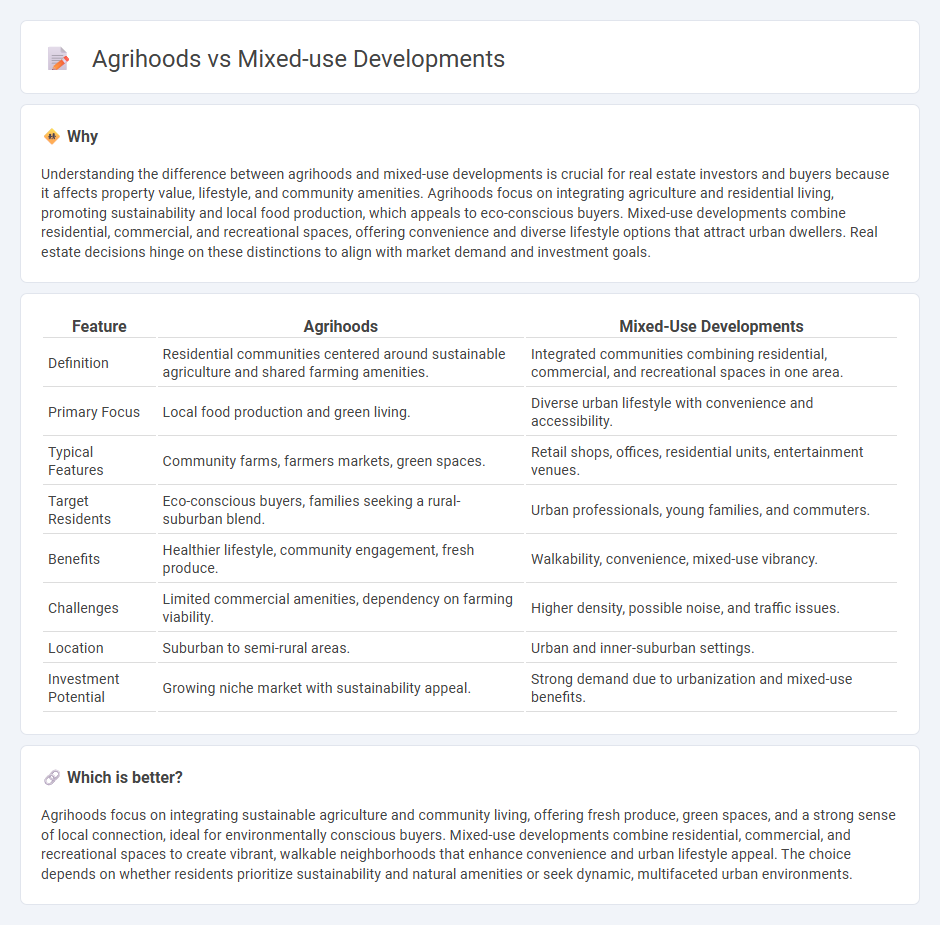
Agrihoods integrate residential living with sustainable agriculture, offering residents fresh produce and a strong community connection centered around farming. Mixed-use developments combine residential, commercial, and recreational spaces within a single area, promoting walkability and vibrant urban lifestyles. Explore how these innovative real estate models are reshaping modern communities and lifestyle preferences.
Why it is important
Understanding the difference between agrihoods and mixed-use developments is crucial for real estate investors and buyers because it affects property value, lifestyle, and community amenities. Agrihoods focus on integrating agriculture and residential living, promoting sustainability and local food production, which appeals to eco-conscious buyers. Mixed-use developments combine residential, commercial, and recreational spaces, offering convenience and diverse lifestyle options that attract urban dwellers. Real estate decisions hinge on these distinctions to align with market demand and investment goals.
Comparison Table
| Feature | Agrihoods | Mixed-Use Developments |
|---|---|---|
| Definition | Residential communities centered around sustainable agriculture and shared farming amenities. | Integrated communities combining residential, commercial, and recreational spaces in one area. |
| Primary Focus | Local food production and green living. | Diverse urban lifestyle with convenience and accessibility. |
| Typical Features | Community farms, farmers markets, green spaces. | Retail shops, offices, residential units, entertainment venues. |
| Target Residents | Eco-conscious buyers, families seeking a rural-suburban blend. | Urban professionals, young families, and commuters. |
| Benefits | Healthier lifestyle, community engagement, fresh produce. | Walkability, convenience, mixed-use vibrancy. |
| Challenges | Limited commercial amenities, dependency on farming viability. | Higher density, possible noise, and traffic issues. |
| Location | Suburban to semi-rural areas. | Urban and inner-suburban settings. |
| Investment Potential | Growing niche market with sustainability appeal. | Strong demand due to urbanization and mixed-use benefits. |
Which is better?
Agrihoods focus on integrating sustainable agriculture and community living, offering fresh produce, green spaces, and a strong sense of local connection, ideal for environmentally conscious buyers. Mixed-use developments combine residential, commercial, and recreational spaces to create vibrant, walkable neighborhoods that enhance convenience and urban lifestyle appeal. The choice depends on whether residents prioritize sustainability and natural amenities or seek dynamic, multifaceted urban environments.
Connection
Agrihoods integrate residential living with active agricultural spaces, promoting sustainable food production within community designs. Mixed-use developments blend residential, commercial, and recreational spaces, often incorporating agrihood elements to enhance local food access and community interaction. This connection fosters healthier lifestyles, strengthens local economies, and advances environmentally responsible real estate trends.
Key Terms
**Mixed-Use Developments:**
Mixed-use developments integrate residential, commercial, and recreational spaces within a single project, promoting urban density and walkability while reducing reliance on cars. These developments typically include retail shops, office spaces, apartments, and public areas, supporting diverse community needs and economic activity. Discover how mixed-use projects are reshaping city landscapes and boosting sustainable urban growth.
Zoning
Mixed-use developments integrate residential, commercial, and recreational spaces under zoning regulations that promote urban density and multifunctional land use. Agrihoods, primarily zoned for residential and agricultural purposes, emphasize sustainable living and community farming within a suburban or peri-urban setting. Explore more about how zoning influences the planning and benefits of these innovative community designs.
Vertical Integration
Mixed-use developments integrate residential, commercial, and entertainment spaces to maximize urban land use efficiency, while agrihoods combine residential living with community-supported agriculture, emphasizing local food production. Vertical integration in agrihoods enhances sustainability by streamlining food supply chains from farm to table within the neighborhood, contrasting with mixed-use projects that prioritize diversified urban functions. Explore how vertical integration shapes the future of community living and urban sustainability.
Source and External Links
Supporting Active Living Through Mixed-Use Developments - This blog discusses how mixed-use developments can support active living by combining residential, commercial, and civic spaces within walking distance.
Benefits of Mixed-Use Development in Urban Areas - Mixed-use developments combine residential, commercial, and sometimes industrial spaces to optimize land use and foster vibrant communities.
8 Different Types of Mixed-Use Development - This guide explores various types of mixed-use developments, including vertical, horizontal, and transit-oriented developments, highlighting their contributions to urban environments.
 dowidth.com
dowidth.com